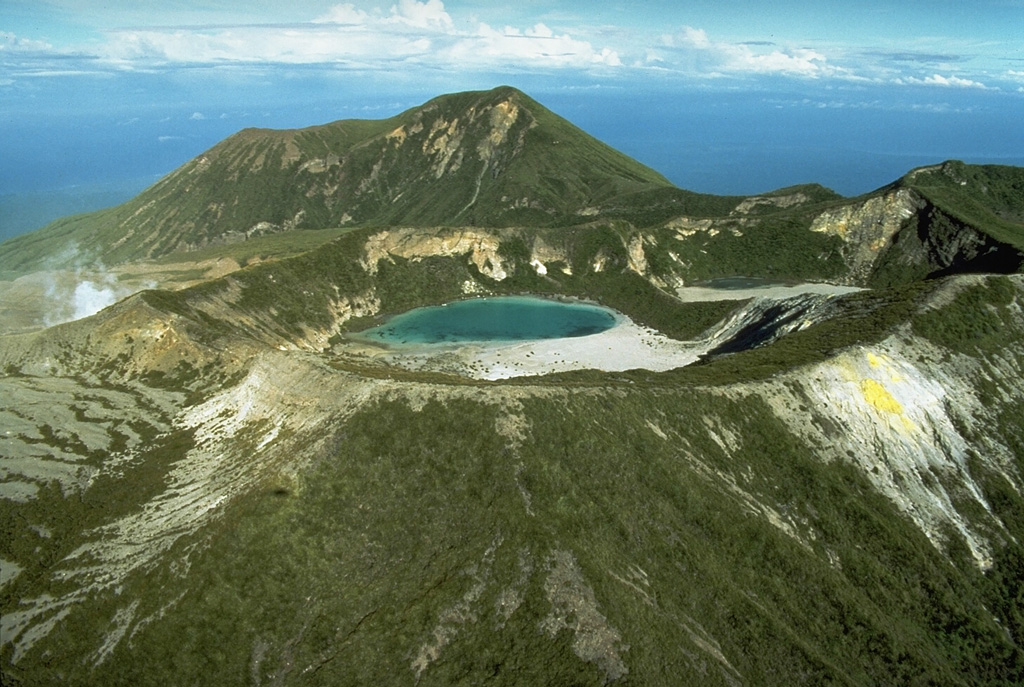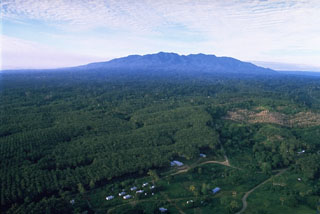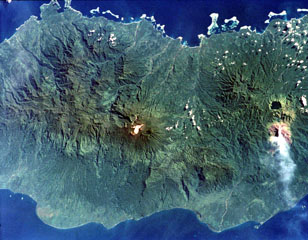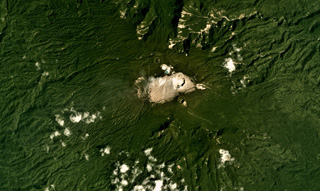

Based on information from RVO, the Darwin VAAC reported that Balbi erupted on 7 May. Ash was not detected on satellite imagery. [Correction: RVO later confirmed that Balbi did not erupt on 7 May and attributed the reports to thunderstorm activity.]
Source: Darwin Volcanic Ash Advisory Centre (VAAC)
Profuse steaming from the summit amphitheater
Aerial inspection was carried out on 22 August, after the 16 August, M 7.8 earthquake that struck 100 km to the W. The inspection revealed profuse white vapor coming from large-output fumaroles in the main fumarole field of the stratovolcano's summit amphitheater. In contrast, emissions at Crater B were moderate and from diffused sources.
Recent landslides were noted in two of the summit craters. The more extensive slides were on the W wall of Crater B. These landslides were thought to have been caused by shaking during the 16 August earthquake.
In general, the visible activity at Balbi appeared to be similar to that observed during previous inspections in the late 1980's. However, emissions may have been more voluminous in 1995.
Balbi marks the highest point on Bougainville Island, forming a summit composed of coalesced cones and lava domes and hosting a large solfatera field. Interviews with local inhabitants suggested that Balbi's last eruption took the lives of a number of people in about 1800-1850.
Information Contacts: Patrice de Saint-Ours and Ben Talai, RVO.
2008: April
Based on information from RVO, the Darwin VAAC reported that Balbi erupted on 7 May. Ash was not detected on satellite imagery. [Correction: RVO later confirmed that Balbi did not erupt on 7 May and attributed the reports to thunderstorm activity.]
Source: Darwin Volcanic Ash Advisory Centre (VAAC)
Reports are organized chronologically and indexed below by Month/Year (Publication Volume:Number), and include a one-line summary. Click on the index link or scroll down to read the reports.
Boiling mud, active fumaroles and solfataras
Balbi, Bougainville's highest point, is in the N-central part of the island on the axial volcanic chain. In [what is possibly an eroded caldera at the summit of the composite cone, seven craters] lie on a N-S ridge about 3 km long. [There are also two cones about 2 km W of the line of craters.] Only Crater B, about 600 m in diameter and second from the S, shows activity. Anthropological evidence suggests an explosive eruption accompanied by nuées ardentes and fatalities, sometime between 1800 and 1850 [but recent geological work does not support this.]
"A boiling mud pool and up to a dozen large, very active fumaroles flanked the lineament of craters. Large collapses have occured into Crater B, and further extensive tension cracks were visible around the crater's rim. Many small solfataras were still active in the W wall of Crater B. The lake in Crater C had diminished in size." [Recent RVO investigations show that the fumaroles are aligned orthogonally to the 7-crater lineament and that the mud pool is no longer active.]
Information Contacts: K. McCue, Bougainville Copper Ltd., Panguna [with January 1988 additions from RVO].
Summit fumarole field remains active
"A brief aerial inspection of Balbi was made on the 27th. No changes were noted. Voluminous white emissions continued from the 1-km-long fumarole field in the NE part of the summit amphitheatre, and from sources in one of the summit craters (Crater B)."
Information Contacts: B. Talai and C. McKee, RVO.
Profuse steaming from the summit amphitheater
Aerial inspection was carried out on 22 August, after the 16 August, M 7.8 earthquake that struck 100 km to the W. The inspection revealed profuse white vapor coming from large-output fumaroles in the main fumarole field of the stratovolcano's summit amphitheater. In contrast, emissions at Crater B were moderate and from diffused sources.
Recent landslides were noted in two of the summit craters. The more extensive slides were on the W wall of Crater B. These landslides were thought to have been caused by shaking during the 16 August earthquake.
In general, the visible activity at Balbi appeared to be similar to that observed during previous inspections in the late 1980's. However, emissions may have been more voluminous in 1995.
Balbi marks the highest point on Bougainville Island, forming a summit composed of coalesced cones and lava domes and hosting a large solfatera field. Interviews with local inhabitants suggested that Balbi's last eruption took the lives of a number of people in about 1800-1850.
Information Contacts: Patrice de Saint-Ours and Ben Talai, RVO.
|
|
||||||||||||||||||||||||||
There is data available for 0 confirmed Holocene eruptive periods.
[ 1825 ± 25 years ] Uncertain Eruption
| Episode 1 | Eruption (Explosive / Effusive) | Crater B ? | |||||||||||||||||||
|---|---|---|---|---|---|---|---|---|---|---|---|---|---|---|---|---|---|---|---|---|
| 1825 ± 25 years - Unknown | Evidence from Unknown | |||||||||||||||||||
|
List of 2 Events for Episode 1 at Crater B ?
|
||||||||||||||||||||
This compilation of synonyms and subsidiary features may not be comprehensive. Features are organized into four major categories: Cones, Craters, Domes, and Thermal Features. Synonyms of features appear indented below the primary name. In some cases additional feature type, elevation, or location details are provided.
Synonyms |
| Tutue |
 Mount Balbi is seen here from the village of Wakunai, E of the volcano along the NE coast of Bougainville Island. Balbi is the largest volcano on the island and has a NW-SE-trending chain of vents.
Mount Balbi is seen here from the village of Wakunai, E of the volcano along the NE coast of Bougainville Island. Balbi is the largest volcano on the island and has a NW-SE-trending chain of vents. Balbi volcano forms the highest point on Bougainville Island and is part of a large number of coalesced cones and lava domes. Five well-preserved craters occupy a NW-SE-trending ridge N of the summit, which also has a crater. Crater C, containing a small lake, is seen here from the E. A plume from a fumarole field on the W flank of 600-m-wide Crater B is visible to the left. The latest eruption may have been as recent as the mid-19th century.
Balbi volcano forms the highest point on Bougainville Island and is part of a large number of coalesced cones and lava domes. Five well-preserved craters occupy a NW-SE-trending ridge N of the summit, which also has a crater. Crater C, containing a small lake, is seen here from the E. A plume from a fumarole field on the W flank of 600-m-wide Crater B is visible to the left. The latest eruption may have been as recent as the mid-19th century. Tore volcano is in the Emperor Range on NW Bougainville Island. The Tore massif lies to the left of Balbi volcano, which is the light-colored area at the center of the image. Two Pleistocene ignimbrites from Tore formed a broad fan that extends the coastline to the W (lower left). The dark-colored caldera lake of Billy Mitchell volcano is at the right, above a plume originating from Bagana volcano. N is to the upper left of this NASA image.
Tore volcano is in the Emperor Range on NW Bougainville Island. The Tore massif lies to the left of Balbi volcano, which is the light-colored area at the center of the image. Two Pleistocene ignimbrites from Tore formed a broad fan that extends the coastline to the W (lower left). The dark-colored caldera lake of Billy Mitchell volcano is at the right, above a plume originating from Bagana volcano. N is to the upper left of this NASA image. A series of craters have formed along a NW-SE-trending ridge on Balbi, seen in this January 2018 Planet Labs satellite image monthly mosaic (N is at the top; this image is approximately 15 km across). Part of the summit area is vegetation-free and geothermal activity continues.
A series of craters have formed along a NW-SE-trending ridge on Balbi, seen in this January 2018 Planet Labs satellite image monthly mosaic (N is at the top; this image is approximately 15 km across). Part of the summit area is vegetation-free and geothermal activity continues.There are no samples for Balbi in the Smithsonian's NMNH Department of Mineral Sciences Rock and Ore collection.
| Copernicus Browser | The Copernicus Browser replaced the Sentinel Hub Playground browser in 2023, to provide access to Earth observation archives from the Copernicus Data Space Ecosystem, the main distribution platform for data from the EU Copernicus missions. |
| MIROVA | Middle InfraRed Observation of Volcanic Activity (MIROVA) is a near real time volcanic hot-spot detection system based on the analysis of MODIS (Moderate Resolution Imaging Spectroradiometer) data. In particular, MIROVA uses the Middle InfraRed Radiation (MIR), measured over target volcanoes, in order to detect, locate and measure the heat radiation sourced from volcanic activity. |
| MODVOLC Thermal Alerts | Using infrared satellite Moderate Resolution Imaging Spectroradiometer (MODIS) data, scientists at the Hawai'i Institute of Geophysics and Planetology, University of Hawai'i, developed an automated system called MODVOLC to map thermal hot-spots in near real time. For each MODIS image, the algorithm automatically scans each 1 km pixel within it to check for high-temperature hot-spots. When one is found the date, time, location, and intensity are recorded. MODIS looks at every square km of the Earth every 48 hours, once during the day and once during the night, and the presence of two MODIS sensors in space allows at least four hot-spot observations every two days. Each day updated global maps are compiled to display the locations of all hot spots detected in the previous 24 hours. There is a drop-down list with volcano names which allow users to 'zoom-in' and examine the distribution of hot-spots at a variety of spatial scales. |
|
WOVOdat
Single Volcano View Temporal Evolution of Unrest Side by Side Volcanoes |
WOVOdat is a database of volcanic unrest; instrumentally and visually recorded changes in seismicity, ground deformation, gas emission, and other parameters from their normal baselines. It is sponsored by the World Organization of Volcano Observatories (WOVO) and presently hosted at the Earth Observatory of Singapore.
GVMID Data on Volcano Monitoring Infrastructure The Global Volcano Monitoring Infrastructure Database GVMID, is aimed at documenting and improving capabilities of volcano monitoring from the ground and space. GVMID should provide a snapshot and baseline view of the techniques and instrumentation that are in place at various volcanoes, which can be use by volcano observatories as reference to setup new monitoring system or improving networks at a specific volcano. These data will allow identification of what monitoring gaps exist, which can be then targeted by remote sensing infrastructure and future instrument deployments. |
| Volcanic Hazard Maps | The IAVCEI Commission on Volcanic Hazards and Risk has a Volcanic Hazard Maps database designed to serve as a resource for hazard mappers (or other interested parties) to explore how common issues in hazard map development have been addressed at different volcanoes, in different countries, for different hazards, and for different intended audiences. In addition to the comprehensive, searchable Volcanic Hazard Maps Database, this website contains information about diversity of volcanic hazard maps, illustrated using examples from the database. This site is for educational purposes related to volcanic hazard maps. Hazard maps found on this website should not be used for emergency purposes. For the most recent, official hazard map for a particular volcano, please seek out the proper institutional authorities on the matter. |
| IRIS seismic stations/networks | Incorporated Research Institutions for Seismology (IRIS) Data Services map showing the location of seismic stations from all available networks (permanent or temporary) within a radius of 0.18° (about 20 km at mid-latitudes) from the given location of Balbi. Users can customize a variety of filters and options in the left panel. Note that if there are no stations are known the map will default to show the entire world with a "No data matched request" error notice. |
| UNAVCO GPS/GNSS stations | Geodetic Data Services map from UNAVCO showing the location of GPS/GNSS stations from all available networks (permanent or temporary) within a radius of 20 km from the given location of Balbi. Users can customize the data search based on station or network names, location, and time window. Requires Adobe Flash Player. |
| DECADE Data | The DECADE portal, still in the developmental stage, serves as an example of the proposed interoperability between The Smithsonian Institution's Global Volcanism Program, the Mapping Gas Emissions (MaGa) Database, and the EarthChem Geochemical Portal. The Deep Earth Carbon Degassing (DECADE) initiative seeks to use new and established technologies to determine accurate global fluxes of volcanic CO2 to the atmosphere, but installing CO2 monitoring networks on 20 of the world's 150 most actively degassing volcanoes. The group uses related laboratory-based studies (direct gas sampling and analysis, melt inclusions) to provide new data for direct degassing of deep earth carbon to the atmosphere. |
| Large Eruptions of Balbi | Information about large Quaternary eruptions (VEI >= 4) is cataloged in the Large Magnitude Explosive Volcanic Eruptions (LaMEVE) database of the Volcano Global Risk Identification and Analysis Project (VOGRIPA). |
| EarthChem | EarthChem develops and maintains databases, software, and services that support the preservation, discovery, access and analysis of geochemical data, and facilitate their integration with the broad array of other available earth science parameters. EarthChem is operated by a joint team of disciplinary scientists, data scientists, data managers and information technology developers who are part of the NSF-funded data facility Integrated Earth Data Applications (IEDA). IEDA is a collaborative effort of EarthChem and the Marine Geoscience Data System (MGDS). |